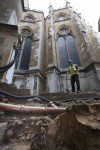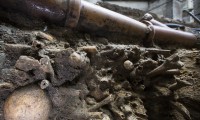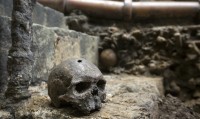 Demolition of a 1950s block of bathrooms outside Westminster Abbey’s Poet’s Corner has revealed scores of human skeletal remains dating to the 11th and early 12th century. The lavatory block is being removed to make way for the Abbey’s first new tower in almost 300 years, a subtle addition nestled behind the buttresses of the chapter house that will provide new and improved access to the Abbey’s attic (triforium) museum. Underneath Victorian drainage pipes, archaeologists found bones from at least 50 people, many of them disarticulated and stacked like cord wood, others in graves lined with chalk slabs in Anglo-Saxon/early Norman style, plus the remains of a three-year-old child buried in a wooden coffin and one adult man buried in an expensive coffin of Northamptonshire Barnack stone.
Demolition of a 1950s block of bathrooms outside Westminster Abbey’s Poet’s Corner has revealed scores of human skeletal remains dating to the 11th and early 12th century. The lavatory block is being removed to make way for the Abbey’s first new tower in almost 300 years, a subtle addition nestled behind the buttresses of the chapter house that will provide new and improved access to the Abbey’s attic (triforium) museum. Underneath Victorian drainage pipes, archaeologists found bones from at least 50 people, many of them disarticulated and stacked like cord wood, others in graves lined with chalk slabs in Anglo-Saxon/early Norman style, plus the remains of a three-year-old child buried in a wooden coffin and one adult man buried in an expensive coffin of Northamptonshire Barnack stone.
The child is too young to have been pledged to the monastery or to have worked there, and the fact that he or she was buried in a wooden coffin indicates a high social status. The bones aren’t preserved enough to determine sex by visual examination. The adult man is missing his skull. His stone coffin was moved to its current location by work crews under Sir George Gilbert Scott, the Gothic Revivalist architect and Surveyor to the Fabric at Westminster Abbey who restored the 13th century chapter house in the 1860s. Scott had the coffin moved because it would have blocked a new window in the chapter house and had it built into a brick wall. The coffin bears the tell-tale signs of interference from this period. A corner of the lid is broken, likely the result of workers lifting it to have a look inside. The skull was probably removed at that time.
 The original Romanesque church that would become Westminster Abbey was built by saint and king Edward the Confessor as part of an expansion of the Benedictine monastery on the site. He dedicated it to Saint Peter the Apostle but it was known as the “west minster” in contrast to St. Paul’s Cathedral which was London’s minster to the east. St. Peter’s was completed in 1065 only days before Edward’s death. He was buried in front of the high altar.
The original Romanesque church that would become Westminster Abbey was built by saint and king Edward the Confessor as part of an expansion of the Benedictine monastery on the site. He dedicated it to Saint Peter the Apostle but it was known as the “west minster” in contrast to St. Paul’s Cathedral which was London’s minster to the east. St. Peter’s was completed in 1065 only days before Edward’s death. He was buried in front of the high altar.
It was King Henry III, a highly devout man who took Edward the Confessor as his patron saint, who decided to replace Edward’s church with a new one in the glamorous Gothic style pioneered by Abbot Suger in the Church of Saint-Denis in the mid-12th century. Henry envisioned the soaring new church as a more majestic shrine for Edward’s bones and those of England’s kings and queens. The Romanesque church was demolished in 1245 and construction began. Saint Edward’s remains were translated to the new shrine on October 13th, 1269. By the time Henry died in 1272, the apse and radiating chapels of the eastern end, the north and south transepts and choirs were completed.
 The stacking of the bones was the work of Henry III’s construction team.
The stacking of the bones was the work of Henry III’s construction team.
Paw Jorgensen, who supervised the excavation by specialist firm Pre-Construct Archaeology, said they had originally been buried in a small burial ground just outside the south transept walls. The highest status individuals, the kings, queens and most senior clergy, would have been buried within the church itself, but the newly found remains were close enough to indicate they probably were those of senior clergy. When Henry demolished Edward the Confessor’s church and began his own massive construction project, the land was dug up, and they were all reburied in a layer under the surface of what was the 13th-century masons’ yard, littered with chips of the stone used to build a platform to take the enormous weight of the new building.
 Some of the skulls have small square holes in them which were likely caused by Henry’s workers wielding pickaxes with less than pious care. Even with holes the stacked bones are in quite good condition, much better condition than the chalk-lined graves which have been damaged by leaks in the Victorian drainage pipes. Archaeologists hope laboratory analysis of the bones will pinpoint who they were, their profession, age, diet, health and where they were raised.
Some of the skulls have small square holes in them which were likely caused by Henry’s workers wielding pickaxes with less than pious care. Even with holes the stacked bones are in quite good condition, much better condition than the chalk-lined graves which have been damaged by leaks in the Victorian drainage pipes. Archaeologists hope laboratory analysis of the bones will pinpoint who they were, their profession, age, diet, health and where they were raised.
Jorgensen says the lavatory block is “built as solidly as a nuclear bunker” making it “a nightmare to demolish.” As the tedious process continues, archaeologists expect to find more bones. As it is, the 50 or so already discovered bring the total number of people known to have been buried in Westminster Abbey to an impressive 3,350. Once the remains have been studied, they will be reburied in the grounds on the church.